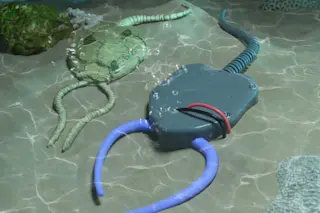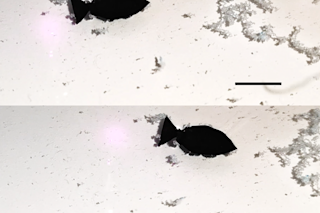While some of their colleagues develop robotic cats and dogs, an electrical engineering team from the University of California at Berkeley chose a less obvious animal to emulate. Ron Fearing, Kristofer Pister, biologist Michael Dickinson, and their colleagues are building a robotic insect loosely based on the blowfly, a common pest. The robo-fly has a one-inch wingspan and weighs less than a hundredth of an ounce. Its wings are composed of rigid polymer. Thin strips of ceramic material connected to its thorax contract in response to electricity, pulling on the wings and causing them to twist and flap.
Photographs courtesy of UC Berkeley Robotics Lab (3)
In a recent test, a tethered one-winged robo-fly managed to flap vigorously enough to rotate a miniature boom. To get off the ground, the fly will have to produce about 10 times as much lift, but the researchers believe it can be done. The ...














